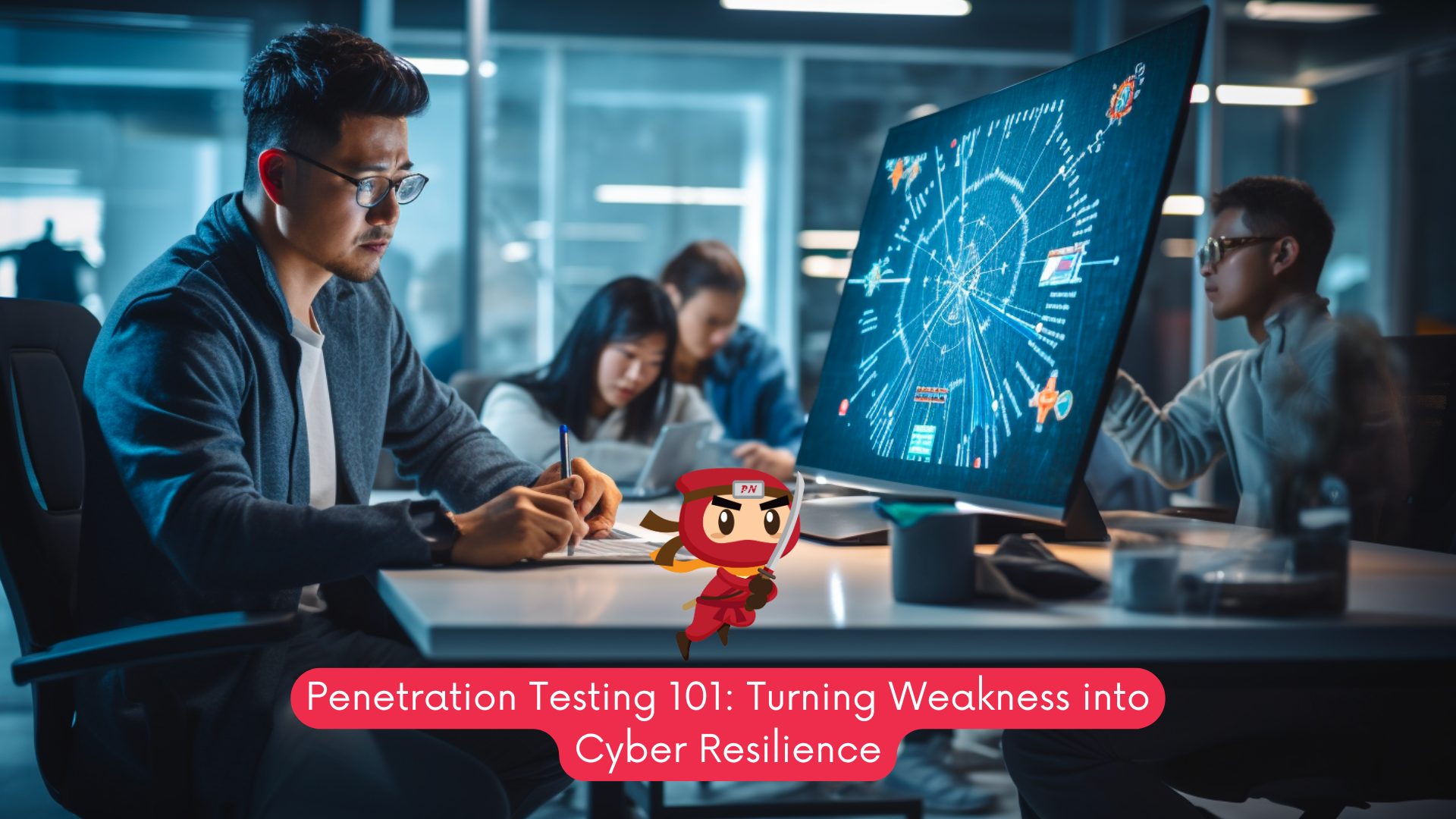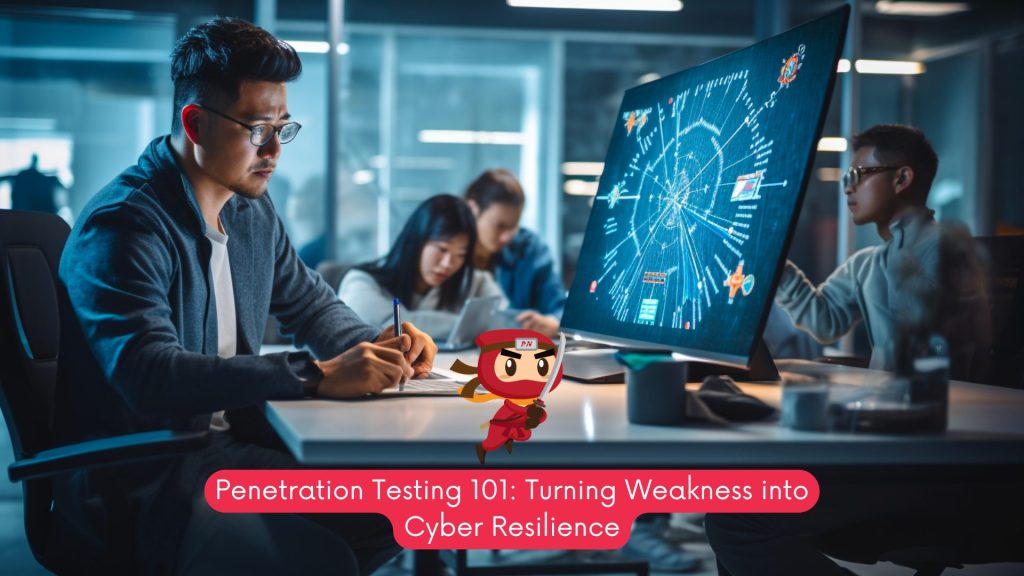KEEP IN TOUCH
Subscribe to our mailing list to get free tips on Data Protection and Cybersecurity updates weekly!







In today’s hyperconnected world, cybersecurity threats are not just technical nuisances. They are existential risks that can cripple operations, damage reputations, and cost millions in remediation.
According to IBM’s Cost of a Data Breach Report 2024, the average cost of a breach reached USD 4.88 million globally, with human error and unpatched vulnerabilities remaining among the top causes. For Singaporean organisations navigating an increasingly digital economy, the stakes are higher than ever.
Penetration testing, or ethical hacking, has emerged as one of the most effective ways to uncover hidden weaknesses before real attackers exploit them. But beyond the technical jargon, what does penetration testing actually involve? How does it help businesses build stronger, more resilient systems?
At Privacy Ninja, we believe that understanding the process is key to recognising its value. The journey from discovery to protection can be summed up in four essential stages: Discover, Report, Exploit, and Secure. Each step plays a critical role in transforming vulnerabilities into opportunities for fortification.
The first step in any penetration test is discovery, an investigative process that involves scanning systems, networks, and applications for vulnerabilities. This is where the ethical hacker’s mindset begins to mirror that of a real attacker. The goal is to identify every potential entry point, from outdated software and weak passwords to insecure APIs and misconfigured servers.
Discovery is both an art and a science. Using advanced scanning tools and manual techniques, testers probe systems to map their structure and understand where weaknesses might reside. According to the Cyber Security Agency of Singapore’s (CSA) Cyber Landscape 2024 Report, 67 per cent of malware infections in Singapore were traced to unpatched or outdated software, an alarming reminder that even the most basic oversights can have severe consequences.
But discovery is not simply about listing flaws; it’s about contextual understanding. A seemingly minor misconfiguration in one part of a system could provide a pivot point for deeper compromise. That’s why thorough discovery lays the foundation for all subsequent stages. Without it, organisations remain blind to the risks lurking in their digital environments.
Once vulnerabilities are identified, they must be properly documented and prioritised. The reporting stage transforms raw technical data into structured, actionable intelligence. A good penetration test report does not merely list weaknesses. It tells a story about risk.
Effective reports classify vulnerabilities based on severity, likelihood of exploitation, and potential business impact. For instance, a publicly accessible database containing customer records is far more critical than an outdated plugin on a test server. Clear, concise, and prioritised findings enable management to make informed decisions about which issues to fix first.
This stage is also where communication matters most. The most successful security strategies bridge the gap between IT professionals and decision-makers. Reports that explain vulnerabilities in plain language ensure that even non-technical stakeholders, such as board members or compliance officers, understand the implications. As the Monetary Authority of Singapore’s Technology Risk Management Guidelines emphasise, transparency between technical teams and leadership is essential for sound risk governance.
The exploitation phase is often the most revealing, and sometimes the most misunderstood, part of penetration testing. Here, ethical hackers attempt to exploit the discovered vulnerabilities in a controlled and authorised manner to understand their true impact.
Unlike malicious actors, penetration testers operate within agreed boundaries. The aim is not to cause damage but to demonstrate what could happen if those vulnerabilities were left unaddressed. This stage validates which weaknesses are truly exploitable and helps determine how an attacker might escalate privileges, move laterally across systems, or exfiltrate sensitive data.
For example, a vulnerability scan might flag hundreds of issues, but only a handful might actually be exploitable. By actively testing these, penetration testers provide clarity, saving organisations time and resources while revealing critical gaps that automated tools often miss.
This hands-on validation also enables organisations to test their detection and response capabilities. If the internal security team fails to notice the simulated intrusion, it highlights where monitoring and incident response processes need strengthening. As recent breaches across industries have shown, from healthcare to financial services, delayed detection often amplifies the damage of real-world attacks.
The final step in the process is securing the environment. Once vulnerabilities are confirmed and documented, organisations must move quickly to patch, reconfigure, or otherwise mitigate them. However, the “secure” phase extends beyond simple remediation. It’s about long-term improvement and learning.
Security is not static. Systems evolve, new updates are released, and threat actors constantly refine their tactics. Penetration testing is therefore not a one-time event but part of an ongoing cycle of defence. The insights gained from one test inform future policies, staff training, and system upgrades.
At this stage, collaboration between the technical team, management, and third-party vendors becomes vital. Remediation is most effective when it’s integrated into a broader governance framework. Following up with post-remediation validation, another form of mini-penetration testing, ensures that fixes are correctly applied and no new risks have been introduced in the process.
CSA’s guidance reinforces this proactive stance, urging organisations to integrate penetration testing into regular security audits to stay ahead of emerging threats.
The cyber threat environment in 2025 is markedly more complex than it was even a few years ago. With the rise of Ransomware-as-a-Service, AI-driven phishing, and state-sponsored attacks targeting critical infrastructure, complacency is no longer an option. Attackers no longer rely solely on brute force; they use automation, social engineering, and even machine learning to bypass defences.
Penetration testing gives businesses an invaluable advantage: foresight. It allows them to see their systems through an attacker’s lens and take pre-emptive action before damage occurs. For industries bound by regulatory obligations, such as finance, healthcare, or real estate, regular testing also ensures compliance with frameworks like Singapore’s Personal Data Protection Act (PDPA) and the Cybersecurity Act.
As cyber threats evolve, the key to survival lies not just in prevention, but in preparation. That’s where Privacy Ninja comes in. We provide a comprehensive suite of cybersecurity services designed to uncover vulnerabilities before attackers do.
Our Vulnerability Assessment and Penetration Testing (VAPT) service combines automated scanning with manual testing conducted by certified ethical hackers. This hybrid approach ensures accuracy, depth, and relevance, highlighting both technical flaws and their real-world business implications.
Privacy Ninja’s team goes beyond detection. We provide detailed reports, actionable remediation plans, and expert guidance to help your organisation secure its systems effectively. Our approach mirrors the four critical steps: Discover, Report, Exploit, and Secure. This ethos is aimed at delivering not only compliance, but more importantly, confidence.
Complementing our VAPT services, we also offer Data Breach Management, DPO-as-a-Service, and Smart Contract Audits for blockchain applications, ensuring full-spectrum protection across your digital ecosystem.
Partnering with Privacy Ninja means gaining more than a technical service provider. It means having a trusted ally in your cybersecurity journey. We help transform vulnerabilities into resilience, so your business can thrive in a world where digital threats are inevitable, but compromise doesn’t have to be.